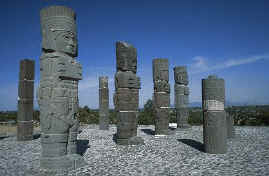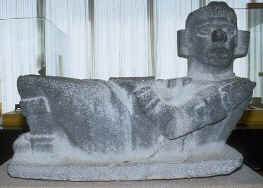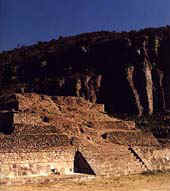 The
Toltec Empire appeared in the Central Mexico area in the 10th century AD, when
they established their central city of Tula. It is believed
that the Toltecs were refugees from the northern Teotihuacán culture and
migrated after its fall in 700 AD.
The
Toltec Empire appeared in the Central Mexico area in the 10th century AD, when
they established their central city of Tula. It is believed
that the Toltecs were refugees from the northern Teotihuacán culture and
migrated after its fall in 700 AD.
Little is known directly about the Toltecs because the Aztecs plundered the Tula ruins for building materials for their nearby capital, destroying most of the historical evidence that remained. Much of what we know about the Toltecs comes from legends carried on about them by later cultures.
The Toltec Empire was the first of the extreme militaristic cultures in the region that used their might to dominate their neighbors, a trend associated with the later cultures in the region, especially the Aztecs. Eventually the empire spread across most of Mexico, Guatemala, and as far south as the Yucatan, as they conquered lands previously controlled by the Mayans.
Art and Entertainment
 The
Toltec Empire and leaders created an unmatched mystique in the minds of the
Central American people. The Toltec leaders were thought of as being alongside
deities. Later cultures often revered them and copied their legends, art,
buildings and religion. Many future rulers of other cultures, including Mayan
leaders and Aztec emperors, claimed to be descended from the Toltecs.
The
Toltec Empire and leaders created an unmatched mystique in the minds of the
Central American people. The Toltec leaders were thought of as being alongside
deities. Later cultures often revered them and copied their legends, art,
buildings and religion. Many future rulers of other cultures, including Mayan
leaders and Aztec emperors, claimed to be descended from the Toltecs.
The Toltecs sported the familiar ball game played by many central American cultures and may have sacrificed of the losers. Toltecs are known for their somewhat rougher form of architecture, a form that would later inspire the Aztec builders. Toltec art is characterized by walls covered with snakes and skulls, images of a reclining Chak-mool (red jaguar), and the colossal statues of the Atlantes, men carved from great columns.
Religion and Legend
|
|
Religion in the Toltec Empire was dominated by two major deities. The first, Quetzalcoatl, is shown as a plumed serpent. This deity of learning, culture, philosophy, fertility, holiness and gentility was absorbed from earlier cultures in the area. His rival was Tezcatlipoca, the smoked mirror, known for his warlike nature and tyranny.
The greatest ruler of the Toltecs was Ce Acatl Topiltzin who was renown for being the leader and high priest of Quetzacoatl at the time when Tula and the Empire were established. According to Toltec legend, Tezatlipoca's followers drove Topiltzin and the followers of Quetzalcoatl out of the city around 1000 AD. They fled south, where they were able to defeat the Maya at the city of Chichen Itza, and take it for their own. An interesting twist in Topiltzin's legend is that he vowed to return to Tula from the east in one of his sacred years and take his vengeance. This legend lived all the way to the time of the Aztecs, who attributed the arrival of the Spanish as the return of Topiltzin, an event that they feared greatly.
The Decline
|
|
The Toltec Empire lasted until the 12th century, when it was destroyed by the Chitimecs and other attacking groups. The Toltec people were absorbed by the conquerors and in the south they became assimilated with the Maya, subordinates to the people they once conquered. After the fall of the Toltecs, central Mexico fell into a period of chaos and warfare without any single ruling group for the next 200 years, when the Aztecs gained control.
Tula
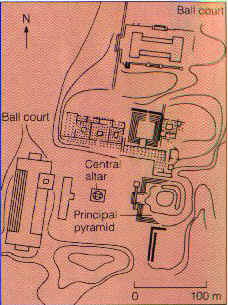 Tula
was the capital city of the Toltec Indian Empire. The ruins can still be found
forty miles northwest of present day Mexico City which is located on the
northern edge of Mesoamerica. It is situated in the Mexican state of Hidalgo and
is placed near the modern town of Tula de Allende. The area is in the Valley of
Aahuac or what is now called the Valley of Mexico. It is one of the most arid
regions where little can be grown, with the exception of maguey, an intrinsic
supplier of needles, sap and other products used by the Toltecs. In addition,
the city is located on a natural promontory with steep slopes surrounding the
city on three sides.
Tula
was the capital city of the Toltec Indian Empire. The ruins can still be found
forty miles northwest of present day Mexico City which is located on the
northern edge of Mesoamerica. It is situated in the Mexican state of Hidalgo and
is placed near the modern town of Tula de Allende. The area is in the Valley of
Aahuac or what is now called the Valley of Mexico. It is one of the most arid
regions where little can be grown, with the exception of maguey, an intrinsic
supplier of needles, sap and other products used by the Toltecs. In addition,
the city is located on a natural promontory with steep slopes surrounding the
city on three sides.
The city rose to power after the collapse of Teotihuacan to take control of the basin of Mexico at approximately 968 AD. Even though the city attempted to fill the political shoes of Teotihuacan, the evidence shows that the city was much smaller. The city is laid out on a grid pattern with a ceremonial core and surrounded by pyramids. The city was organized into households which are approximately 1,970 feet (600 meters) square. Inside of these formal households were square or rectangular flat-roofed houses which were grouped into as many as five dwellings which all shared a shrine. The city ruins are characterized by giant stone warriors placed at the temples by the Toltecs.
It's maximum size and power was achieved between 950 and 1150 AD and its largest population was between 40,000 and 60,000 people. Its largest geographic size was between 13 and 16 square kilometers. There is much archeological evidence that shows that Tula had lost much of its power and was at least partially abandoned by the year 1200 AD. Many experts think this phenomenon occurred due to a drought and famine which ravaged the city. With the collapse of the city, the temples and pyramids of Tula were razed by other Indian tribes.
Teotihuacán the City
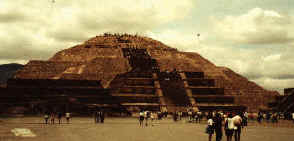 The
main basis of anthropological knowledge and speculation about the Teotihuacán
culture is based on the city of the same name Teotihuacán. The city is located
approximately 30 miles northeast of Mexico City in the Basin of Mexico.
Teotihuacán was the first metropolitan city of the Americas with a probable
population of 125,000 during the fifth and sixth centuries A.D. The city
declined between the seventh and tenth centuries A.D. until it was finally
abandoned. Excavation of the city has given us many clues about their culture.
The
main basis of anthropological knowledge and speculation about the Teotihuacán
culture is based on the city of the same name Teotihuacán. The city is located
approximately 30 miles northeast of Mexico City in the Basin of Mexico.
Teotihuacán was the first metropolitan city of the Americas with a probable
population of 125,000 during the fifth and sixth centuries A.D. The city
declined between the seventh and tenth centuries A.D. until it was finally
abandoned. Excavation of the city has given us many clues about their culture.
Teotihuacán the Culture
The discovery of Teotihuacán artifacts and pottery in other sites in Latin
America and the abundance of the cultural artifacts of other groups found within
the city of Teotihuacán lead to the conclusion that the Teotihuacán were
actively involved with trade. There is mounting evidence that the Teotihuacán were involved in trade relationships as far away
as the Mayan lowlands, the Guatemalan highlands, northern Mexico and the Gulf
Coast of Mexico.
evidence that the Teotihuacán were involved in trade relationships as far away
as the Mayan lowlands, the Guatemalan highlands, northern Mexico and the Gulf
Coast of Mexico.
We also know the Teotihuacán were extremely religious due to the amount of religious artifacts and buildings in the city. Impressively, Teotihuacán contains more temples than any other pre-hispanic Mesoamerican site. There are two main pyramids, the Pyramid of the Sun and the Pyramid of the Moon, dedicated to worship. Also, the Temple of Quetzalcoatl with magnificent heads of plumed serpents built into the walls were built for religious purposes. Each precisely drawn out compound in Teotihuacán contains at least one smaller temple or shrine to their gods, suggesting that the people worshipped communally within each compound.
Besides the religious significance of the compounds, they also give evidence to the social structure and residence pattern of the Teotihuacán. The different sizes, amount of artifacts and architectural differences of the complexes point to the conclusion that Teotihuacán had a social structure divided by class. In addition, biological studies of the skeletal material at the sites suggests that the males within one of the complexes were closely related. This study indicates a Patrilocal family residence pattern which means that the females of the Teotihuacán moved in with their husband's family after marriage. Further evidence suggests that the residents of the compounds may have shared certain economic skills such as working obsidian. In addition, there may have been foreign communities living within Teotihuacán.
The Decline of Teotihuacán
The city of Teotihuacán declined from one of the largest metropolitan cities in Mexico in the fifth and sixth centuries A.D. to virtual abandonment in the seventh and eighth centuries A.D. Although archeologists can document the actual abandonment of the city, there is little evidence pointing to why it may have been abandoned. An increase in the amount of militarism in the art and artifacts of that period suggests an increase in warfare which could be a possible explanation. After 750 A.D. there is evidence of ritual-like burning of the monuments and temples of the city which has been associated with loss of power and decline.
